#it’s like if retro rpgs had modern quality of life stuff
Explore tagged Tumblr posts
Text

if you have a Mole Interest, you can experience Molekin in the turn-based rpg video game Sea of Stars (which is really really really good u should play it)
#mole interest#sea of stars#it’s a rly good video game#you’re Youths trying to save the world from Magical Destruction and you go to so many cool places#as one of the few remaining and two newest Solstice Warriors#it’s like if retro rpgs had modern quality of life stuff#it feels like a mishmash of super Mario rpg; Chrono trigger (has references to it in the game hehe); final fantasy; bravely default kinda?#and 90s/handheld 2D Zeldas#but with its own flavors ofc#and it’s Gorgeous#and it’s challenging but has stuff you can turn on to make battles easier
60 notes
·
View notes
Text
B&C Behind the Scenes: Retro Video Capture On a Budget
People who follow Bread and Circuses know that the blog is dedicated almost entirely to pop culture analysis. But people who are my friends also know that I’m a huge geek for computer hardware. So today, you’ll get you a man who can do both. This is my first behind the scenes feature, where I talk about crazy learning experiences in being a small-time YouTuber. This piece will be very technical, so I don’t blame you for skipping it.

The next project for Bread and Circuses is a full documentary and retrospective on Final Fantasy IX (2000, PlayStation), maybe the most important game in my life and one of the best RPGs ever made. Due to the scope of the video, I’m replaying all the original Final Fantasy games for the original PlayStation to jog my memory and give context for the less researchy parts. I am doing this on original hardware and a tube TV, without resorting to emulation or the re-releases. And I’ll be recording the entire game.
The choice for original hardware came for a few reasons. For one, the newer ports of Final Fantasy games are…mixed, at best. IX’s updated ports feature higher quality models and cutscenes, but the backgrounds are blurry, the new fonts and interface are hideous, and the overall “feel” of the original game is somewhat lost. As inspiration for writing the script, I also want the nostalgic experience of how I first experienced the game.
With that being said, I had a major hurdle to overcome: how do I record 50+ hours of gameplay from a 1995 console?
Step 1: Capture Setup
Most game capture these days is done in two ways: via the device playing the game, or via a capture card. The first method is quite easy on PC: you just fire up Open Broadcaster Suite, use a quick setup guide and you’re good to go. This is what I’ve done for all my videos thus far.
For modern consoles, you can use an HDMI capture card like the Elgato HD60. The cards aren’t exactly cheap, but they’re affordable enough for most streamers and let’s players.
But there’s one problem: both the original PlayStation and PlayStation 2 do not have HDMI output. The early model PS3s can play PS1 games and have native HDMI, but they are rare, expensive, and often break.
While you can buy HDMI adapters for the OG PlayStation, they are spotty in quality and present yet another challenge: such adapters often introduce noticeable input lag. Though FFIX is not a fast-paced game, the lag is still bothersome. They also don’t work with my tube TV, which is critical for my desired creative process.

That leaves me with two capture options: composite or S-Video. Composite video is the little yellow guy you used to plug into your tube TV. It looks decent on those, but when captured digitally, the blurriness and drab colors are immediately apparent. It’s for this reason that I purchased S-video cables; without going into boring technical detail, S-Video delivers far richer colors. Because the adapter includes both, I can output to my TV and computer at the same time with no additional equipment!
Speaking of adapters, the PS2 also has the option to output component video, arguably the best analog video available. While capture solutions exist for component video, my tube TV does not accept it. So to use component, I would need a system of complicated adapters and converters to both record on my computer and play on my TV at the same time. It’s too much hassle for not enough results.
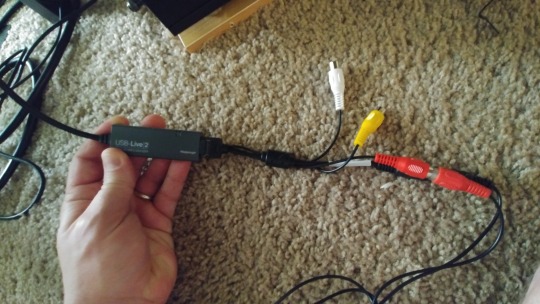
So instead, I did some research and bought this little guy: the Hauppauge USB Live-2. There are many adapters like it, but Hauppauge has brand recognition in this area. This adapter also uses 4:2:2 chroma subsampling, meaning that it sacrifices very little in color depth compared to some cheaper models. It plugs into any USB port.
My tube TV only supports mono sound, which means it only needs one audio cable. I hooked up the left channel (white cable) to my TV, and the right channel (red cable) to my capture card. When outputting FFIX in mono mode, both devices receive the same sounds, and the music doesn’t suffer from missing stereo effects. Perfection.
Step 2: PS1 or PS2?
So as most people know, the PlayStation 2 is backwards compatible with original PlayStation games. The method by which this is done, however, differs based on the model.
Early PS2s have an actual PS1 processor on their motherboard. For the PS2 it’s used for sound and input/output, but when playing a PS1 game this CPU is instead, providing nearly perfect PS1 support. Sony actually did the same thing with the first PS3, but soon realized it was very expensive and scrapped it.
For later models of the PS2 – the slimlines – Sony switched to software emulation to save costs and space. The software emulation works very well, but it is just that: emulation. It is very rare for emulators to be literally perfect replications of the original experience, and Sony’s for the PS2 – called POPS – is not 100% accurate. I also don’t have a slim, so there’s that.
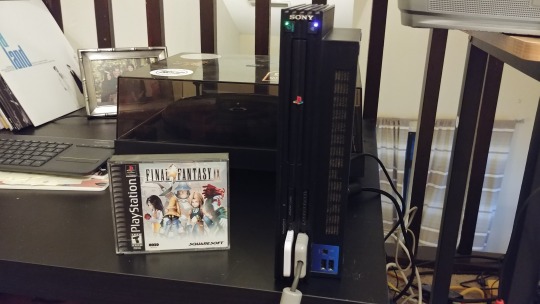
But I’m getting ahead of myself. I first dug out my old PlayStation 1, purchased new in 1998. While the system itself still works shockingly well (despite some skipping during movies), I quickly ran into a problem: the PS1 outputs at 240p. For the uninitiated, video nomenclature like 240p refers to the number of lines in the image along with the scan type. So 240p means there are 240 lines of pixels in the image, and they are updated progressively, meaning all at once.
Older tube TVs can accept 240p input, but output it in interlaced form. This means that the TV quickly updates every other line of the image, rather than the entire image at once. It works pretty good for this type of TV, but on a modern monitor introduces some problems…which I’ll get to in a bit.
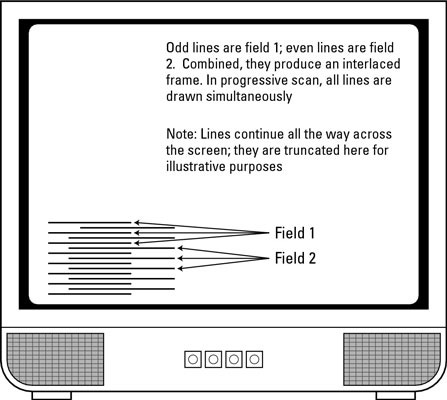
Image from dummies.com. Fitting.
However, this was a problem for me because my new capture card did not accept 240p input. I tried countless times to get it to accept PS1 video, and it just didn’t work. However, I noticed that my PS2 did. That’s because the PS2 outputs by default at 480i, an interlaced mode that my capture card accepted.
So I opted to use my “fat” PS2 instead, which is a SCPH-30001 model, purchased new in 2001. It includes the original PlayStation chip, and – to my enormous surprise – read my original Final Fantasy IX CDs perfectly. Because the PS2 accepts PS1 controllers and PS1 memory cards, it was an almost flawless version of the original PS1 experience. Awesome!
Step 3: Recording
With setup out of the way, I got to the final step of the project: actually recording digital video.
I use Open Broadcaster Software (OBS) for all my video and streaming projects. It’s free, powerful, and pretty fast. My capture device was immediately detected by OBS, but there was one immediate problem.
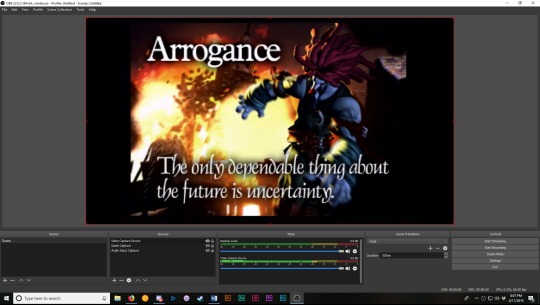
Remember the interlacing I mentioned earlier? When you display interlaced video on a progressive screen – AKA any modern flat-panel monitor – you get a horribly ugly effect where the video seems to be ripping itself apart. This is called combing, and it sucks. Thankfully, OBS supports native deinterlacing, so I was able to fix it right up.
That being said, let’s break down the different parts of recording with OBS:
Resolution: the PS2 outputs in 720x480 pixels, but my videos are at 1920x1080. However, recording at 1080p requires more hardware power, so I get more definition at the expense of less overall quality. I chose instead to record at 720p, which is closer to the PS2’s native resolution and allows me to capture better colors with less blur.
Framerate: this is where things got interesting. I master all of my videos at 60 frames per second. Very, very few PS1/2 games (FFIX included) hit 60fps, because the hardware of the time just wasn’t capable of rendering graphics that fast. However, they do output at a 60 hertz refresh rate, meaning that the image updates 60 times per second even if the console doesn’t actually produce new frames that fast. So if you record at under 60fps, you get noticeable judder in your footage. That being said, 60fps was a requirement.
Encoding: I wanted to get the highest possible quality picture. My computer has a Ryzen 5 1600 processor – a capable mid-range CPU – and is excellent at software video encoding. I used the OBS x264 encoder running at medium quality. Any higher than medium and I started experiencing skipping footage as my CPU went to 100% utilization. I gotta admit, it’s pretty cool hearing my computer fans kick into overdrive as the CPU is pushed to its limits.
Bitrate: I’m recording a lot of footage here, so while I needed high quality, I also have to keep storage limitations in mind. I did some experimenting and decided on a bitrate of 9000kbps, still above YouTube quality while also saving space. This also means that each hour of footage is about 4GB; given that FFIX is about 40 hours long, that means roughly 160GB of footage for the game. Not bad, considering.
Deinterlacing: OBS presents a slew of options for deinterlacing your footage, and the differences can be tough to spot. The only option that gave me zero trouble – no juddering or excessive blur – was Yasif 2x. I also increased the brightness and saturation to make up for some of the analog video deficiencies.
I’ve included sample footage below, along with pictures of my setup. If you’re an aspiring retro YouTuber or streamer, feel free to PM me with any questions. This stuff was kinda intimidating to figure out and I’m happy to help!
Until then, I’ll be in Gaia. Or Terra, once I hit Disc 3.
Jon
Full Setup
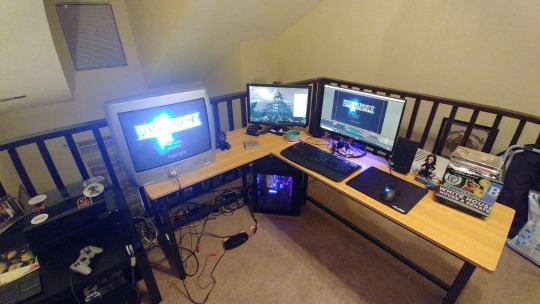
Cable Routing Detail
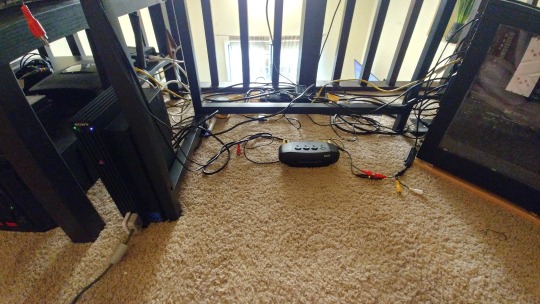
The TV inputs run through this old AV hub I dug up from my teenage bedroom. This lets me run the cables behind my desk to keep things a bit neater. I say a bit because you can still see the cables back there, but that’s showbiz, baby.
Sample Footage
youtube
#ff9#ffix#final fantasy ix#retro#gaming#ps1#ps2#playstation#capture#hauppauge#video#editing#project#documentary#video essay#criticism#games#2000s
10 notes
·
View notes
Text
10 Games
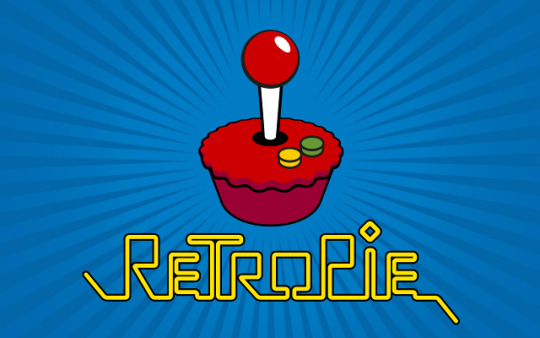
For Jack’s 10th birthday, Will got him a RetroPie. Pretty cool, especially since it’s so easy to just dump a zillion games in there and let the kid go nuts. But that’s a one-way ticked to analysis paralysis, so Will had a a super sick idea. He asked me and Jess and some other friends to put together a list of 10 must-play classic/retro games and write a little bit about why we chose them. As someone who loves video games and writing and lists, I was ALL ‘BOUT THAT.
Now that Jack’s birthday has come and gone, I can share all the junk I wrote about these ten games that mean so much to me! Check it out:
I love this idea. I know the initial prompt was just "pick your favorites" but I couldn't help but impose a bunch of additional caveats. I know where this list is headed (and I have a pretty good idea of what games will pop up on the other lists)! I could have easily listed off 10 Super NES games or 10 N64 games, but I wanted to hit a variety of consoles and franchises. I would have liked to have hit a variety of genres and studios too, but I can't lie: I love platformers, and I love games by Nintendo. It was challenging but rewarding to shave this list down to ten--a lot of old favorites and recent discoveries couldn't fit on the list, leaving these few. The ones I've always treasured, the ones that stuck with me, the ones I memorized the music and sound effects to, starring the characters I love, exploring the worlds I wanted to live in. Maybe you'll dig 'em too.
NES
Super Mario Bros. 3

I had spent some quality time with our Atari 2600 well before we ever had an NES in the house. I have fond memories of playing but not really understanding Pac-Man, Haunted House, and the bleak nuclear apocalypse masterpiece Missile Command. But the first game I really wrapped my head around was Super Mario Bros. (and Duck Hunt, but that's not as relevant!). Mario and Luigi's multi-screen adventures under a friendly blue sky expanded my concept of what a video game could even be--plus it was super fun, and Rochelle and I could both play it together! Super Mario Bros. 2 was technically more impressive, but so weird (and flanked by so many similar games) that it didn't rock my world like Mario 1 did (though I of course have a huge soft spot for it anyway). Then Super Mario Bros. 3 came along and Mario had learned how to fly. It was bigger, more beautiful, and stuffed to the brim with secrets and surprises! It was so exciting even Mom and Dad would play it with us. Super Mario World is maybe the bigger, better, beautifuler game (and you can ride a FREAKING DINOSAUR), but I'll never forget the day I woke up to find my dad and sister playing this in the living room because we finally owned it. It was too good to just keep renting! Kid Icarus

I didn't catch Kid Icarus the first time around. I didn't even play it until high school, but I was inspired to track it down because of my love for Greek mythology and the Metroid series. Kid Icarus takes place in a world heavily inspired by (but still distinctly different from) the swords, sandals, and sorcery epics of ancient Greece! It's considered a "sister game" to the original Metroid, released around the same time by the same team, and the game shares a lot of the core elements that make Metroid so unique and awesome: eerily lonely, dangerous worlds to explore, a challenging beginning, player-empowering character growth, and a focus on exploring vast, often vertically-scrolling worlds with satisfying run'n'gun'n'jump gameplay. Kid Icarus borrows all the best stuff from Metroid, but tempers it with a slate of unique design choices: instead of one sprawling world, KI is split into discrete levels. The first world is an ascent out of Hades with vertically oriented levels, the second world is a horizontal trek across the surface world, the third is another vertical ascent into the sky, and the finale is a horizontal, forced-scrolling shoot-em-up to reclaim the heavens! Every fourth level is a sprawling, maze-like, Metroid-ish dungeon, capped off with a frantic boss fight! Plus, Eggplant Wizards, credit cards, and RPG-style character upgrades! They don't make 'em like this anymore!! Duck Tales

It's not as groundbreaking as Super Mario Bros. 1 or as innovative as Super Mario Bros. 3, but that doesn't change the fact that Duck Tales could possibly be my favorite NES platformer of all time. You don't need to know anything about or even like the original cartoon (or the comic books that birthed it) to appreciate the challenging charms of this hop'n'bop classic. Duck Tales only has a handful of levels, but they're huge, full of hidden treasures, packed with alternate paths, swiss cheesed with secret passageways, and just gorgeous translations of Disney's lush cartoon worlds. Getting to choose your own path through Duck Tales' roster of big beautiful worlds is reminiscent of the Mega Man games (also by Capcom). What really sets Duck Tales apart is controlling Scrooge. He's spry for a septuagenarian billionaire, but his real talents lie in swinging and pogo-sticking off his cane! It's delightful cartoon nonsense, but if you get the hang of it, it's also incredibly satisfying, allowing you to make some wild, death-defying maneuvers. If you dig this and find yourself hungering for more bounce-centric gameplay, Shovel Knight takes Scrooge's cane, turns it into a shovel, and builds a deeply satisfying modern classic around it. Donkey Kong Country: Tropical Freeze finally gives Cranky a chance to shine as a playable character, and he straight-up jock's Scrooge's style, cane and all. It rules.
Super NES
Yoshi's Island

The first thing you'll notice about Yoshi's Island is that it looks like it was drawn with crayons, markers, and colored pencils! The second thing you'll notice is that Mario is a freaking baby! It's an odd premise, but it all comes together in perhaps the best sidescroller ever made. With Mario mustache-less and diaper-clad, this game puts you directly in control of Yoshi, and he is a joy to play as. Hovering to extend his jump power, turning enemies into eggs and chucking them, and butt-stomping are Yoshi's primary tools of the trade, and they mix things up nicely. This doesn't feel like "just another Mario," but it also feels right at home in the Mario pantheon. Beyond the Yosh-man's most basic maneuvers, there are some wild power-ups that turn Yoshi into a helicopter, a train that zips along in the background, a mole-tank, and more, plus special areas where Baby Mario gets superpowers and runs up walls and stuff! Yoshi's Island is another magical micro-world, jam-packed with extremely clever and fun level design and very possibly the biggest and best boss fights of all time. Ya gotta play this one.
Donkey Kong Country 2: Diddy's Kong-Quest
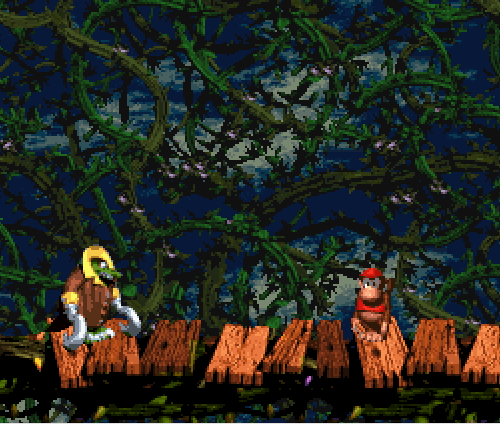
I know I just talked about Yoshi's Island maybe being the best platformer of all time, but Donkey Kong Country 2 is right behind it, nipping at its heels. DKC2 has a wildly different aesthetic, dropping you into beautifully computer-rendered pirate shipwrecks, janky-but-glitzy night time carnival rides, endless bramble patches, a skyscraper-sized beehive, haunted forests, and more! They're not just beautiful to look at, but beautiful to listen to, because DKC2 features one of the all-time greatest video game soundtracks. Maybe the greatest. But this game ain't just another pretty face!
DKC2, like Super Mario Bros. 3 and Duck Tales, is stuffed to the gills with tricky little secrets and hidden areas and surprises. This game doesn't just have secret levels, it has a secret WORLD. This game doesn't just have a secret world, it has an entire secret ENDING. The classically solid platforming is accompanied by a wealth of mine cart challenges, awesome animal buddies, mini-games, and enough level design variety to keep you coming back for every last hidden treasure.
Super Metroid
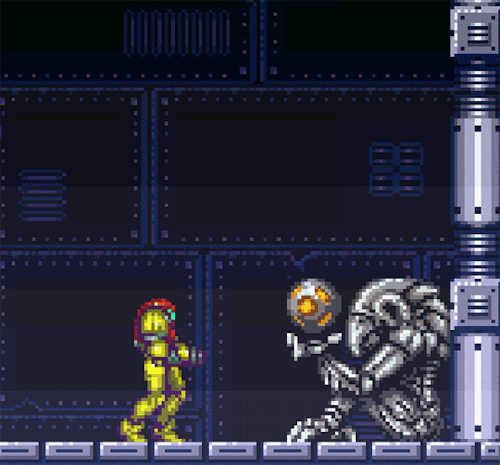
Super Metroid doesn't just have secrets, it has mysteries. This was the first game to ever actually scare me. The first one to ever creep me out. And that just made me want to play it even more. It feels lonely and dangerous. Unlike the games earlier on this list, it is one HUGE and continuous world. It is a world of incomprehensible alien horrors, ancient moldering ruins, and high-tech space-faring bio-terrorists. This world, named Zebes, is a world where the sky continuously rains acid and almost every living thing inhabiting it wants to kill you. Good thing you're Samus Aran, the toughest, smartest bounty hunter to ever clean up Space Pirate scum!
Samus explores this acid-drenched nightmare planet by running, gunning, and jumping... but also by solving puzzles and thinking her way out of traps. With each power up she gets a little stronger, and can find her way deeper into this gnashing alien hellscape. It's a game that is sadly beautiful just as often as it is ghoulish. The story, simple and sketched-in as it is, is also deeper and more moving than you will ever expect. The boss fights are as massive, memorable, and epic as the ones in Yoshi's Island, but about a thousand times more intense and frightening. The music perfectly sets the dark, burbling mood of each region of Zebes, and by the end of the game you will feel like the most powerful hero in the galaxy. This mix of sci-fi, horror, and adventure isn't just a must-play, it's a life-changer.
Gameboy Color
Wario Land II
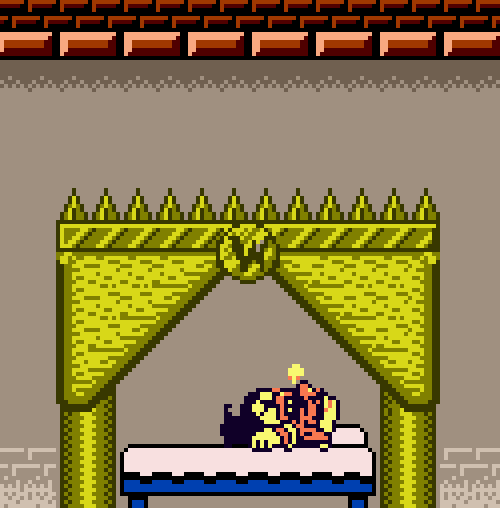
I love the Mario series, but I'm also absolutely crazy about Wario. He's a fat, greedy, chaotic, prideful, disgusting, bull-headed oaf. He's the polar opposite of Mario... and that's why I love him! He's not exactly a villain, but he's a definitely a troublemaker, and it is hilariously fun to walk (or stumble!) a mile or three in his shoes. The game before this, Super Mario Land 3: Wario Land is a ton of fun (as is Super Mario Land 2 before it!), but Wario Land II is the first one that truly feels like a Wario game. What makes this game so different? Wario can't be killed!
You read that right, there's (almost) no way to actually "die" in this game! No way to lose lives. That might sound too easy, or boring, or both, but it's not! Wario might be unkillable, but all KINDS of bad stuff can and WILL still happen to him. A LOT. He'll get flattened, set on fire, trapped in bubbles, fattened up, frozen, drunk, zombified, and more! And here's the kicker: those wacky conditions are required to solve the puzzles and challenges of each level! On top of that ingenious and perfectly wacky set of game mechanics, the story branches off in wildly different directions: you'll blow up the annoying alarm clock in your castle, play street basketball against a giant bunny, be nice to a chicken, visit Atlantis, race through a weird world of mouths, noses, and eyes, and more! There are multiple endings, multiple hidden exits, and multiple secret treasures and minigames to find and conquer. Almost all of the Wario Land and Wario Ware games are oddball masterpieces, but WLII is the perfect balance of weird, smart, funny, and challenging.
Nintendo 64
Super Mario 64
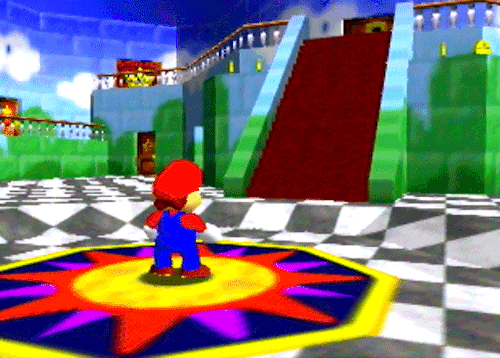
This is it. This is the game. In 1996, when I was in sixth grade, Super Mario 64 was the only thing I cared about. I begged and wished and hoped for a Nintendo 64 that Christmas, but it didn't come. I was crushed. Occasionally I was able to rent an N64 and Super Mario 64, and I'd lose whole days to this magical, miraculous game. When I couldn't rent it, I'd bug my classmates about it endlessly. "What level are you on? What's that level like? What stars can you get? What secrets have you found?" They'd answer a few of my ravenous, bug-eyed questions before getting uncomfortable and leaving to do something else. What was the big deal? Why was I (and still am) so obsessed?
The leap from Super Nintendo to Nintendo 64 was like the leap from console and computer games to virtual reality. But instead of short, funny minigames, it is a huge, sprawling world where anything seems possible. A magical, secret garden full of surprises, wonder, challenges, and secrets. Where the sun always shines in a cloudless sky... except when you plunge into the death-defying Bowser levels or the inappropriately terrifying Big Boo's Haunt. Oh Mario can definitely fly in this one like he did in Super Mario Bros. 3, but just the simple act of running around in circles and jumping through 3D space felt like a joyous miracle... one that puts 2-dimensional flight to shame. Each world (accessed by jumping INTO paintings in Princess Peach's sprawling but empty castle) is colorful, full of possibility, and chock full of distinct personality. Adventuring through 3D space for the first time ever was incredible on its own, but doing it in such richly detailed, lovingly crafted worlds made me want to play there forever. I still do.
The Legend of Zelda: Ocarina of Time

Take everything I just said about Super Mario 64 and multiply it by ten! Well, sort of. Ocarina of Time took the lessons learned from Super Mario 64 and applied them to the dungeon-crawling, puzzle-solving Legend of Zelda series. The result was an incredibly groundbreaking game that I cherished almost as zealously as Super Mario 64. I don't think it's aged as well, but I don't care. Ocarina of Time is a grand story, spanning seven years (!!!) and the entire fantastical country of Hyrule. As Link, you jump forward and back through time, meet strange and wonderful new friends, discover hidden kingdoms, face the blood-soaked evil of Hyrule's past, save its future, outwit cunning puzzles and traps, steal and ride a magnificent horse, challenge towering, Super Metroid-style end bosses, wield magical weapons, break hearts, play beautiful music, and go fishing. It's an entire, epic fantasy life in one little cartridge.
This was the first Zelda game I ever spent SERIOUS time with, and the fact that it plays like a fantasy-fueled hybrid of Super Mario 64 and Super Metroid means I've lost entire days to it. I've played it start to finish at least 8 or 9 times. It never gets boring. Like Super Mario 64, Ocarina of Time invented how we make and play 3D games. This was the first 3D game where you could lock onto enemies and points of interest, plus a bevy of other camera controls that come standard in 3D games now (or at least they did for about a decade after Ocarina's release). The story is surprisingly cinematic and even gripping at times. You'll want to live in this world. You'll be sad when you see the end credits. Not because of the ending itself, but because there's no more game for you to play... until you start it all over again on the next save file.
Star Fox 64
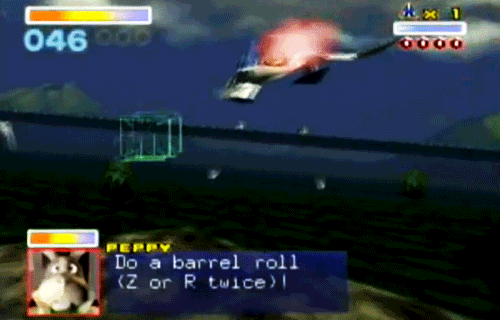
Star Fox 64 was a life-changing event for me, just like Super Mario 64 and Ocarina of Time. So is Star Fox 64 a slow-paced, exploration heavy adventure into beautiful and fantastical solitude like those other two games? N O P E. It's a guns-blazin', fast action, dogfightin', barrel rollin', rock'em sock'em intergalactic action epic in supersonic spaceships! Piloted by talking animals! That actually talk! YES!
Instead of the wide-open freedom of Super Mario 64 and Ocarina of TIme, Star Fox 64 either puts you on (invisible) rails in a forced-scrolling attack run or in a contained 3D arena. Here's the kicker though, the levels are all so perfectly designed and the action is so expertly paced that you never feel restricted. You're too busy racking up kill combos, saving your wingmen, and navigating through flying, burning space debris and buildings and asteroids and terrain to think about what you can't do. And even on rails, Star Fox 64 gives you ways to explore! Most levels have multiple exits and there are a whole mess of different, branching paths through the entire, war-torn Lylat system. The game is designed to be played start to finish in a single sitting, but experimenting with repeat playthroughs is the only way to experience everything this laser-blazing action classic has to offer. On top of all that, it's got a great story, iconic, meme-worthy dialogue, and an absolutely banging soundtrack. It might not have changed the face of interactive entertainment like Super Mario 64 and Ocarina of Time, but it delivered the ultimate shoot'em up space adventure.
4 notes
·
View notes
Photo
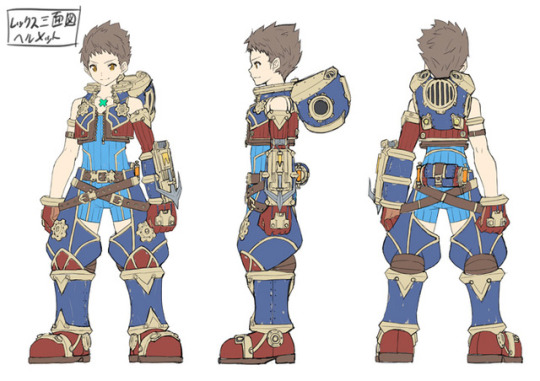
State of the Art: JRPG Spotlight-
Issue #1- 2017 at a Glance- A quarterly or bi-annual journal on the JRPG at large, focusing on recent releases, trends, quarterly reviews/analyses and upcoming release hype.
The other night I was getting yet even deeper still into the freshly minted minor-masterpiece that is Xenoblade Chronicles 2 when it dawned on me just how good 2017 was to the quaint little genre known as the JRPG. I knew all year while it was happening that some special games were getting released with a certain regularity, but now that the dust has fully settled, we can look back and be conclusively impressed by such a stellar stretch.
3 or 4 years ago I think people were getting ready to pen their moratoriums on why big developers and JRPGs should soon plan on never intersecting again save for small-scale handheld releases, and now here we are and Japan is seemingly back on top as far as role-playing goes. That return-to-form didn't always seem so inevitable as it is now that it's fully underway, especially after a somewhat shaky stretch for the genre during the 7th generation. Indeed, high-definition graphics and devs who catered to Gatorade-guzzling gamer bros seemed to not be the boon to the genre that old-school role-players really needed, and even the first couple of years of the 8th generation saw the genre to still be on slightly shaky ground, without a ton of great titles to point to from those initial years.
But then throughout the 7th gen a little franchise called Dark Souls (a JRPG in spirit, though not quite in practice, in many ways) started to build a little following, generating new interest in things like difficulty, customization, and innovative diagetic story-telling. As of the middle of this decade though, the genre still doesn’t have all that much of a presence compared to the late 90s heyday of JRPGs. Cut to 2016 though and Square drops FFXV which is a solid, if not-perfect realization of the 30-year-old standard-bearer of the genre, (a herald of sorts, if you will) and BAM. 2017 begins and in quick succession Nier Automata, Persona 5 and Breath of the Wild drop, all to stunningly positive reception. Now BotW, like Dark Souls, is not as much of a JRPG as the other 3 releases I hope to focus on, but Zelda has always had it's toe in the same waters as Final Fantasy and Dragon Quest, borrowing and simplifying elements of role-playing games from an action-adventure perspective, and in turn, also influencing those very JRPG franchises it seemed to pay homage to.
This wasn't just a coincidental blip of releases though, proved largely by the fact that all the way at the end of the year, Xenoblade 2 would also drop, and show yet again how the JRPG can be fresh and vital, and can be a Nintendo-exclusive at that. Indeed, I hope to demonstrate my thesis that it was a particularly strong year by triangulating my discussion around Nier A, Persona 5 and Xenoblade 2. Not only are these three very strong titles, they are also all pretty vastly different styles of JRPGs, which I think displays the health and potential of the genre even better than the fact that they are so individually good. First of all we have an industry veteran and mad-hatter in Yoko Taro finally coalescing a fully-realized vision of action-JRPG greatness by collaborating with Platinum games to make something as heady, and intellectual as it is well-designed and fun to play. That game is something like a Hegelian Philosophy PhD driving a Lamborghini in terms of the amount of stuff going on with the writing and character development, all while sporting a super classy luxury sports-car, six-cylinder engine. For long-time fans of Taro, I don't think this direction could have ever been predicted, though they may have secretly dreamed of such a fusion of form and function.
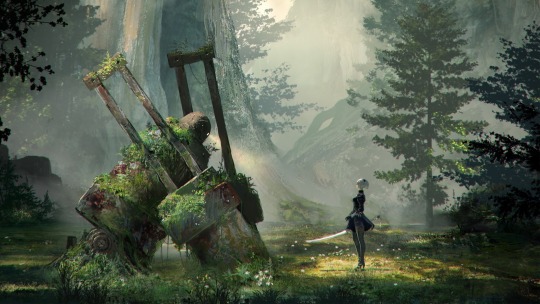
The best thing about how simultaneously weird and playable Nier A is for me is the way it hearkens back to the golden age of PS2 JRPGs for me personally. Without pinning it to a single PS2-era title, it gives me the same feeling that games during that console could consistently deliver on: a fully realized fantasy/sci fi world, a deep-yet-approachable combat system, a weird and very-Japanese, but also deep-as-hell plot, and a certain functionality that games like Kingdom Hearts 2, Rogue Galaxy and Final Fantasy XII delivered on back then. I don't mean to say it's derivative or stuck in the past, it's just that, the highlights of the PS2 days are my go-to precedent for what a good modern, post-16-bit JRPG is, since that equally sweet ps1 era can only be reasonably emulated on smaller and/or handheld retro-style releases. And while the story’s depth and esoteric nature recall the plot’s and worlds of PS1 and 2 greats like FFX, Xenosaga or Vagrant Story, the combat itself feels as fast-and-furious as hack-n-slash classics from then like Devil May Cry.
So while Nier had action-(j)RPG style gameplay covered, Persona 5 was there for all the turn-based devotees, and oh boy were we there for it also. That game was a huge victory lap for Atlus, who has built up a deep fanbase over the past decade, largely because of youtubers (at least in the west we can thank the cult-y presence of its fans online for the slow-burn development of an army of Atlus acolytes, whereas P3 and 4 were only barely noticed in the States back when they actually first came out.) And they finally capitalized on that hard-earned interest by finally following up P4 after nearly a decade, and while they were at it, they also showed everyone that fully turn-based (not even slightly active-time) systems can still melt faces, please crowds and feel fresh, which is no mean feat at all in a world where some question if turn-based is officially dead save for retro-homages.
And while Nier captures a kind of ethereal PS2-esque quality, Persona very literally pulls some of the PS2-era goodness into the future by updating and refining the awesomely deep and OCD-enabling systems of the now holy-grail-level PS2 era Persona games. Yes, wandering around Shinjuku, going on supportive dates with classmates, building up your relationships in general, and working a part time job between study breaks has been fully realized for the modern gamer, and it is glorious to behold.
And that takes us to Xenoblade which out of all the titles I might be most surprised by. Being a bit of a Xeno-noob, I wasn't sure if the release was going to be a major or minor event for role-players, especially given Nintendo's spotty track-record with the JRPG, usually sporting all of maybe one or two truly notable ones per generation, as well as their tendency to censor and/or smother developers. But alas, Xenoblade is fully-formed, proper, brimming-with-life and as deserving of the title of new standard-bearer to the genre as any of the other fantastic JRPGs released that year, many of which I won't even get to.
As is the case with the others, it seems to draw on PS2 era greatness in someways, by building on battle systems like the ones in FFXI and FFXII, while also being an actual descendant of the Xenosaga series that rocked that console, and also still draws on PS3-era titles that were successful (though smaller in number there were some good ones!) like Ni No Kuni and the Last Story. This is a round-about way of saying the combat system is an excellent take on the free-moving active-time auto-battling-but-with-real-time-triggers-style combat that started to show up towards the end of the PS2's life-cycle just when people were realizing the days of pure turn-based role-laying may be limited. And it also delivers on all those other check-marked boxes that any truly great and special JRPG must deliver on including: emotionally stirring and unique soundtrack, a deep and rewardingly complex story with all sorts of specific and detailed lore, a really nice visual style, and some incredibly beautiful locales. Okay that last thing isn't even a thing JRPGs usually have to deliver on, but it sure is a highlight. Some of the locations you move through during your travels in this game are breathtaking, and even more impressive than the similarly psuedo-cell-shaded style of Breath of the Wild, whose open-world Monolith Soft also worked on (though you can't climb all over these areas I should say).
I'm as blown away by the suddenly addictive combat (once it fully kicks in and you are given full control over 3 blades around the 15 hour mark) as I am by the surprisingly moving, funny and immersive story. I can be a little skeptical sometimes when approaching JRPG stories, but by all three of these aforementioned titles, we were treated to surprisingly mature and complex narratives, with refreshingly grounded and/or thoughtful characters. Indeed, with this many games firing on all these different cylinders (I didn't even mention the soundtrack to Persona 5 or Nier OMG), you know something special is happening.

So there you have it, three wildly differently styles of JRPG, only unified by their consistent top-tier quality. An old-school turn-based lite-novel hyprid, a full real-time action-RPG for philosophy students, and a MMO-style combat fantasy epic. And on top of all that there's myriad other fantastic releases, or even re-releases like the Final Fantasy XII Zodiac Age remaster of FFXII, one of my favorites and oft-forgotten FF titles that I think got overlooked slightly upon initial release precisely because of the way it showed other developers the way forward from pure turn-based combat.
And then the behemoth that is Breath of the Wild saw a tried-and-true franchise get fully revitalized in a way that drew on the weapon system of Dark Souls as much as it did the food system of Odinsphere of all games. And like I said, though not a true JRPG, it shows that role-playing adjacent titles are also showing a come-back. Survival components in video games were always the more practical, realist cousin to role-playing/stat-grinding after all.
So where do we go from here? Well 2018 will show us whether 2017 was a stand-out year or just the beginning of a trend, but all signs seem to point to an ongoing upward trend if releases like Monster Hunter World are any indication. Ni No Kuni 2 is due out soon, Octopath Traveler, which should make good on the idea of a retro-JRPG, and Kingdom Hearts 3 at the end of the year all help to paint the picture of an equally formidable year. Alas, Nippon is poised to continue its domination in coming months. All in all, fans of the genre should be very pleased, and if you haven't checked out one of the aforementioned titles get to it, because all of them are excellent, even if Xeno takes about 15 hours to truly get rolling and Persona takes a whopping like 20. All good things come to those who wait, after all.~
#xenoblade chronicles 2#xenoblade#nier automata#nier#persona 5#persona#jrpg#state of the jrpg#role-playing#role playing#role#playing#ps4#switch#turn-based#combat#real-time#state of the art
2 notes
·
View notes
Text
Project Spotlight: Daggerfall Unity
[b]Today we are talking to Interkarma, developer of [url=https://www.nexusmods.com/daggerfallunity]Daggerfall Unity[/url] a Unity port of The Elder Scrolls II: Daggerfall that brings the classic RPG to a new engine substantially improving upon stability and playability. Curious to try it out? Follow the steps outlined [url=https://forums.dfworkshop.net/viewtopic.php?t=2360]here[/url]. [center][youtube]RPEmRzxtJnA[/youtube][/center] First and foremost: could you give us a bit of an introduction to who you are and how you got into modding / programming?[/b] I’m just a normal geeky guy. I was born in Australia and have lived here my entire life. Most of my early life was spent in rural/outback regions due to my father being an opal prospector. I often didn’t have any technology around, not even a television. But comics, board games, and books were usually there to fill in time. I’ve always enjoyed pulling things apart to see how they work. Once I got into computers, I started doing that with software. Early on, I had an Action Replay cartridge for the family C64 that let me pause games at runtime, inspect their assembly code, make changes, rip out sprites, etc. I had a tremendous amount of fun working out how these games did some of the things they were doing and used this to write my own small games and tools. I built tools like a sprite editor, ADSR sound editor, a basic word processor, and games like a side-scrolling shooter, that kind of thing. I kept doing this as I grew up, trying to rebuild small parts of other games to see if I could do it. I didn’t make mods so much as hack around with code and try to understand how the original game was created. I’ve always wanted to create my own original games, and have dozens of ideas I want to work on. It’s only lately though that I really have the time and experience to make that a reality. [b]For those who have never heard of it, how would you describe what Daggerfall Unity is in your own words?[/b] Daggerfall Unity is a superset of classic Daggerfall. I like to describe it as “Classic Daggerfall Plus”. It’s not a remaster in the sense we’ve come to expect when this is done commercially. Rather, it’s a ground-up recreation of the classic game plus quality of life features and modding capabilities. The foundation of the idea was to port the classic Daggerfall experience into a modern game engine and give it modding support like later Elder Scrolls games. The default experience should look and feel a lot like classic, while providing for modders to remix, upgrade, and extend the base game in ways not possible in classic Daggerfall. With some of the mods available now, such as new guilds and airships, I feel like everything is working out even better than I’d hoped. Daggerfall Unity is very much its own game though and doesn’t always do things exactly the same way as classic. Usually, this is due to bug fixes in Daggerfall Unity, or platform differences as the result of playing on a different engine, modern hardware, or higher resolutions. But we’ve worked very hard to ensure the game can be enjoyed extremely closely to its roots. Options like Retro Rendering mode are there to deliver a true 320x200 experience, most QoL features can be toggled on and off, and many control element can be finely tuned. With a bit of patience, players can dial in either an pure retro experience, or mod things closer to Morrowind/Oblivion quality levels, or find something in between. Daggerfall Unity is very flexible in what you can do with the game and most people can find a setup they enjoy playing. [center][img]https://staticdelivery.nexusmods.com/mods/110/images/93729/93729-1572271568-1148969596.png[/img] [img]https://staticdelivery.nexusmods.com/mods/110/images/93729/93729-1572271572-2031988629.png[/img][/center] [b]From what I have learned, the whole project has kept you busy for an unbelievable amount of time. If you had to give an estimation: how many hours/days/years would you say you have put into creating Daggerfall Unity and what kept you going during all this time?[/b] This all began in the year 2001 when I started building tools to explore Daggerfall’s textures, 3D models, map layouts, etc. These were Daggerfall Explorer, Modelling, Imaging, Cartographer, and Jukebox. I started with information on Daggerfall’s file formats available from the UESP and gradually built on this with my own discoveries. I did this on and off for around 12 years, picking away at Daggerfall’s file formats and little mysteries just for my own amusement. I even had a shot at recreating Daggerfall in 2005, but lacked the experience and community then to make much progress. While learning Unity in 2014, I wanted something more challenging to work on. My wife suggested I try porting some of my Daggerfall code into Unity, to use something familiar while learning a new tool. Because most of my code from 2009 was written in C#, it was fairly trivial to port it to Unity. This is how Daggerfall Tools for Unity (DFTFU) was born. I had model importing working in a day, locations in under a week, and the whole world working within a few months. At this stage though, it was just a toolset to import assets. There wasn’t any real gameplay. This all re-sparked interest in recreating Daggerfall, something I was interested in again by that stage. I officially started work on Daggerfall Unity in August 2015 and it has been like a second job ever since. For the next four years, I would spend roughly 6-40 hours per week working on Daggerfall Unity, building a community, managing the codebase, and so on. I’d make the time a by creating a few hours each morning and evening, and basically sinking every weekend into it. [b]What would you say is the main lesson you learned from your time working on this project? What would you tell your younger self about going into a massive undertaking like Daggerfall Unity?[/b] If I was being fair, I’d probably tell my younger self to do something easier instead. Daggerfall is a huge and complex game, and my younger self made the mistake of thinking it was a simple game because it was an older game. That’s just not true, something I worked out really quickly once it came time to build some of the game systems. But now that I’ve come out the other side, I wouldn’t want to change a thing. I’ve become a better programmer, learned how to manage a large project with several developers, and grow an online community. All of this will be invaluable as I move on to creating my own games, something I wanted to do in 2014. I just had to get Daggerfall out of my system first. [b]Did you get a lot of support from the Daggerfall community during development?[/b] Absolutely! The support from the community has been incredible, and it’s the main reason I was able to make it this far. For those first couple of hard years when I was mostly working alone, the love and support I received was the only thing that kept me going. And from around 2017, the number of top-notch contributors exploded and we suddenly had brilliant devs like Hazelnut, Pango, Nystul, Allofich, Lypyl, Ferital, TheLacus, Numidium just pushing things forwards every day with a seemingly endless stream of quality updates and information. Even when I thought we had all the people we needed, devs like Meteoric Dragon came along and added loads of improvements, JorisVanEijden helped expand knowledge of the quest system, Jay_H built, tested, and fixed hundreds of quests, and Pango became an overmind generalist who can help with practically anything including community management. I maintain a full list of contributors at the below forum link. [url=https://forums.dfworkshop.net/viewtopic.php?f=4&t=233]https://forums.dfworkshop.net/viewtopic.php?f=4&t=233[/url] [img]https://staticdelivery.nexusmods.com/mods/110/images/93729/93729-1572271564-410713571.jpeg[/img] [b]Daggerfall (The Elder Scrolls II) was released in 1996, the same year Bill Clinton was re-elected, and Pokemon was first introduced to the world. My point is: Daggerfall came out a very, very long time ago! That being said, what makes Daggerfall as a game special to you and what made you want to revive it by developing Daggerfall Unity?[/b] I played a lot of tabletop RPGs when I was in my teens and twenties. Games like Daggerfall gave me the feeling I was playing the videogame version of a tabletop adventure run by a great DM. There were just so many deep systems to explore and things to discover. When I was playing Daggerfall back in 1996, the web was nowhere near as developed as it is now. Information was a lot harder to find. Daggerfall felt like this big black box to tease open and see how it worked. There were rumours about a dragon being in the game somewhere, and I’d set off into the wilderness looking for it like an idiot. There was always this feeling every time I went into one of those procedurally generated dungeons that I might really be the first person to explore it. There was just something very special about this game back then, and I couldn’t help but want to understand it more. Everything since then has just been a gradual evolution of my love and interest in the game. It’s not something that happened all at once, but rather grew slowly over many years. [b]What can you tell us about the Daggerfall and Daggerfall Unity community? Other than diehard fans who grew up with the game, do you get a lot of people who are only now picking it up to see what it’s all about?[/b] I’m amazed how many younger players are still trying out Daggerfall and Daggerfall Unity in 2019. This isn’t just the domain of older gamers like myself. I feel that Daggerfall Unity helps make the game more accessible to new players. It’s a smoother and more comfortable experience with a lot of QoL features and new stuff to explore through mods. Given the modern popularity of The Elder Scrolls in general, I feel like it’s a great way to experience the series roots in a more comfortable and stable manner. I also encourage die-hard retro gamers to try out the original so they can experience what Daggerfall Unity is building upon. [b]Have you taken notice of [url=https://www.nexusmods.com/skyrimspecialedition/mods/29416]Skygerfall[/url] - a mod for Skyrim that aims to bring the entire main quest of Daggerfall into Skyrim? What are your thoughts on it?[/b] It looks amazing! I haven’t had time to play it yet, but I can tell it was made with love and attention to detail. I’m looking forward to giving it some playtime in the future. [b]Other than Daggerfall (Unity), do you have any other favourite games? Ever done any modding for those?[/b] A few modern favourites are Elite Dangerous, World of Warcraft, Subnautica, Void Bastards, and Outer Wilds. I’ll play almost anything, but I prefer games that give me fun systems to explore and then just take their hands off. I get really annoyed when games constantly try to guide me, or too frequently break gameplay to show me a cutscene, or take away control of my camera to force me to see something. I’m not much of a modder and have only tinkered with creating mods for other games. I tend to fall in love with systems first and gameplay later. Maybe because I grew up with basic stuff like card games and board games before I ever saw a video game, it feels like understanding rules and systems always comes before actually being able to play them. I’m the rare kind of person who prefers a heavy spiral bound manual filled with tables and formulas over an in-game tutorial. [b]Daggerfall Unity is currently released as an alpha. How can people get set up and help you with development going forward?[/b] There’s not much left on the development side that isn’t already allocated out or being worked on by someone. Insofar as the core gameplay, everything is done now and it’s just bug fixes, refinement, and features unique to Daggerfall Unity. It’s hard to imagine getting more help than I already am. There’s always room for more mods though. I strongly encourage anyone interested in developing for Daggerfall Unity now to check out the mod scene and build something awesome. Other than that, the best thing everyone can do is just keep being awesome to each other and help others create new stuff for the game. If we all continue lifting each other up, there’s no telling what people might be creating for Daggerfall Unity in a few years. [center][img]https://staticdelivery.nexusmods.com/mods/110/images/93729/93729-1572272157-1762324444.png[/img][/center] [b]Is there anything else you would like to say to the Nexus Mods community?[/b] I’d like to thank Nexus Mods for supporting Daggerfall Unity and making the lives of our players easier. I also hope [url=https://www.nexusmods.com/daggerfallunity]the mods available today[/url] inspire other creators to make something new for the game. Considering some of the mods starting to appear, I can only imagine what the scene can look like in a few more years. I’m looking forward to seeing where it all goes. [line] A big thank you to Interkarma for taking the time to respond to our questions. As always, if there are any mod authors or mod projects you'd like to hear about, don't hesitate to send a message to [url=https://www.nexusmods.com/users/31179975]Pickysaurus[/url] and [url=https://www.nexusmods.com/users/64597]BigBizkit[/url]. Published first at Project Spotlight: Daggerfall Unity
0 notes